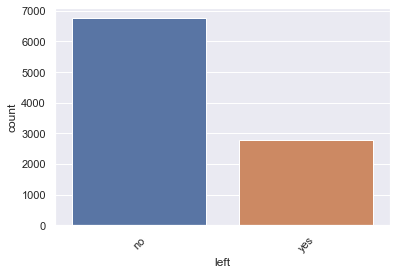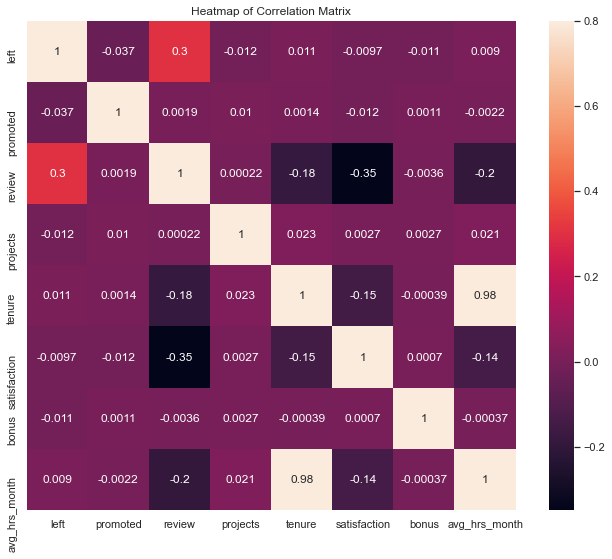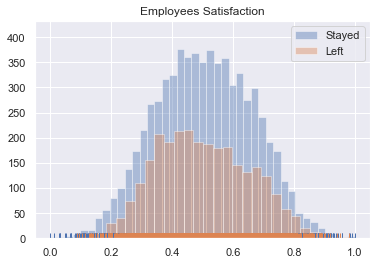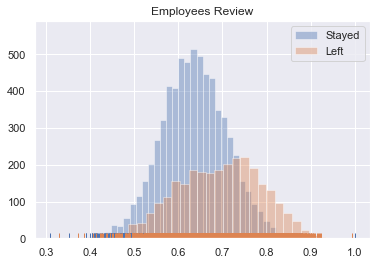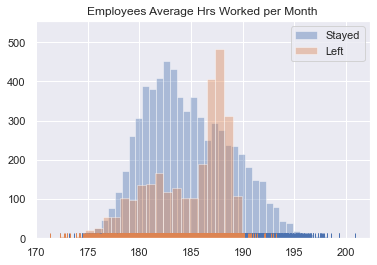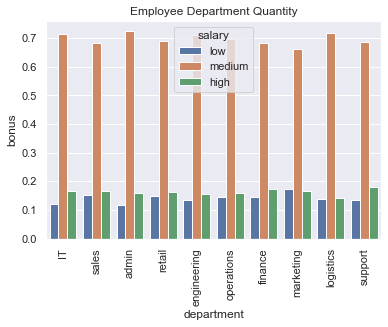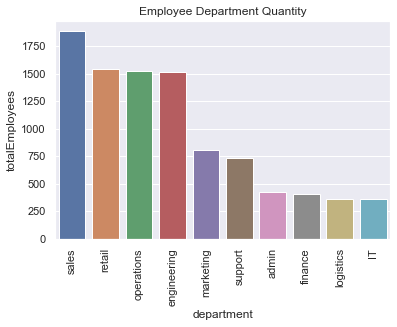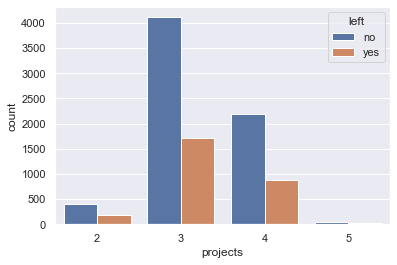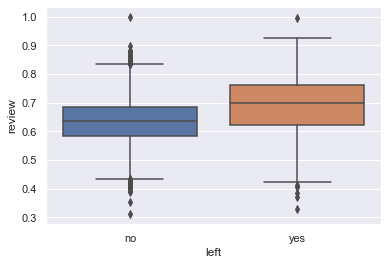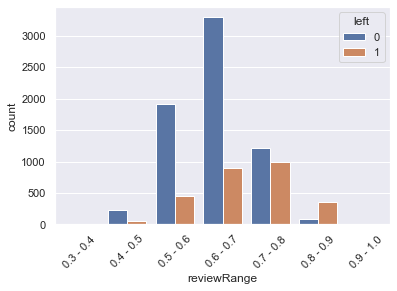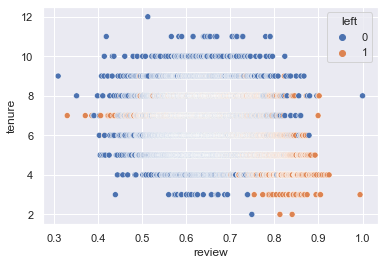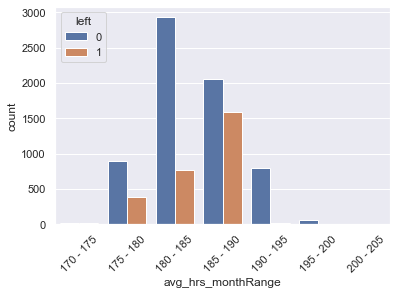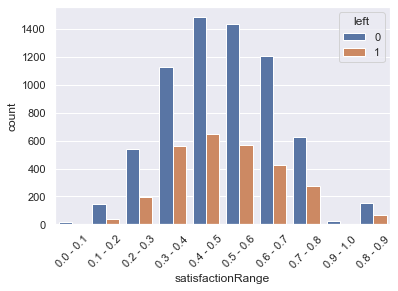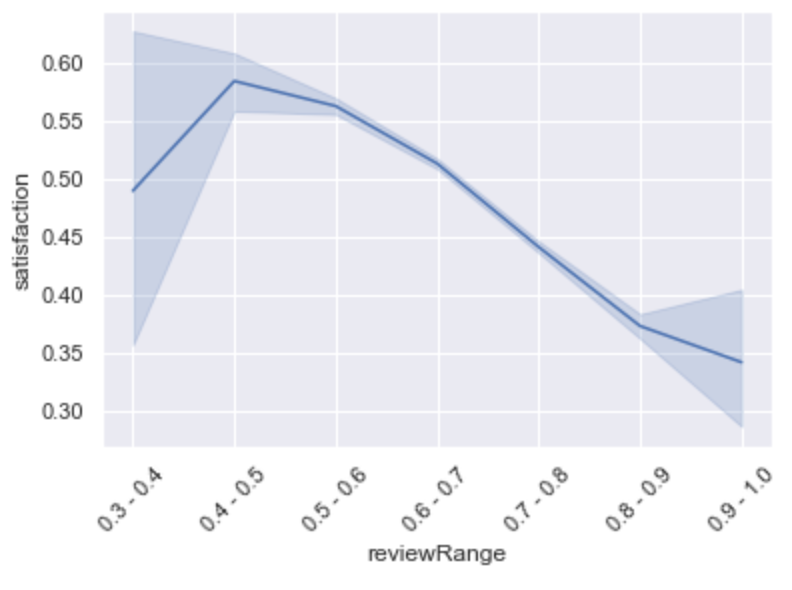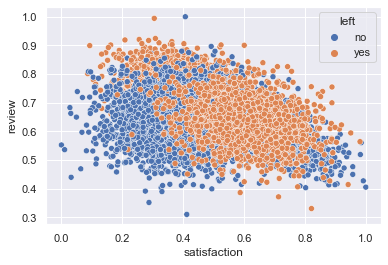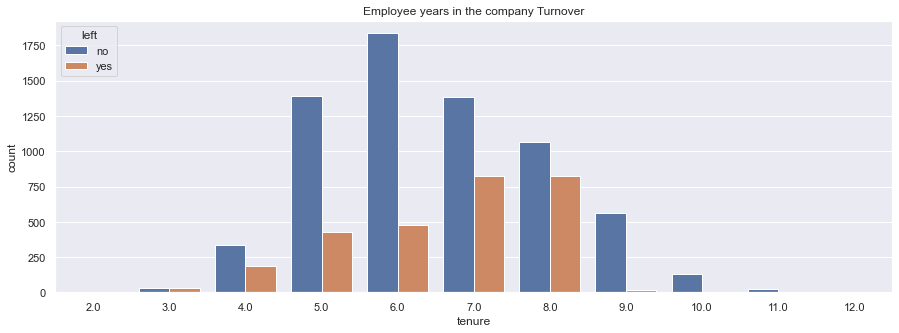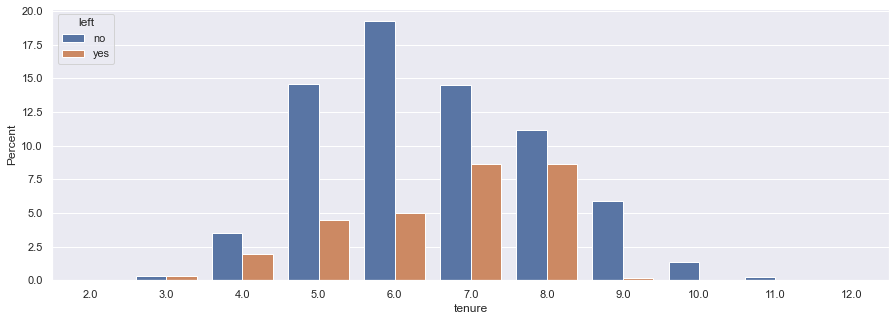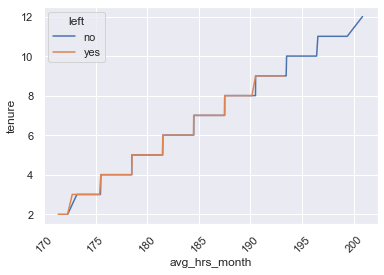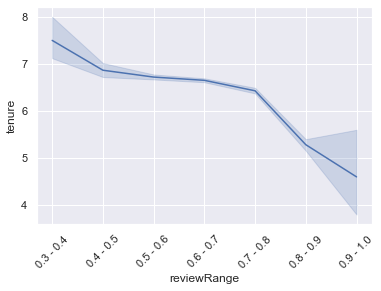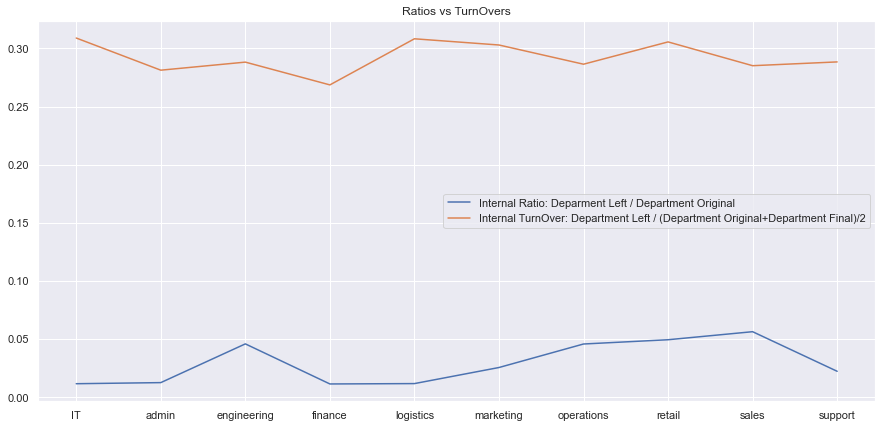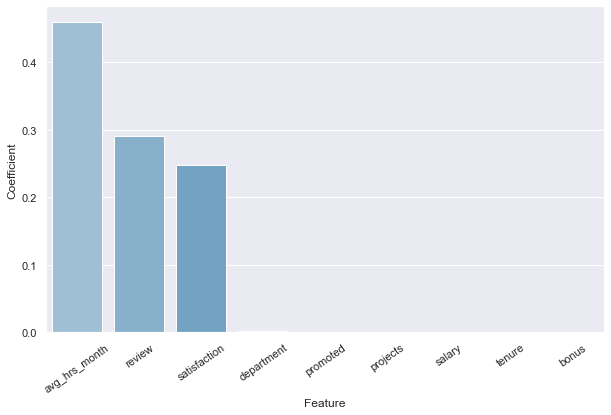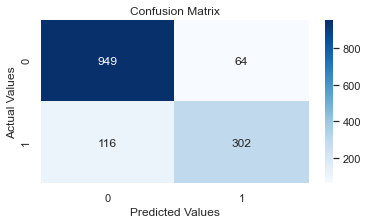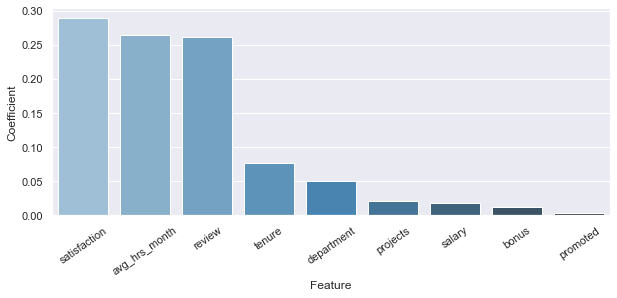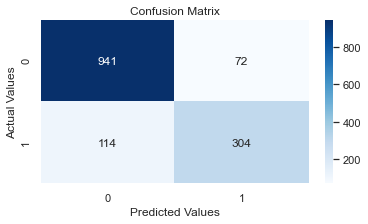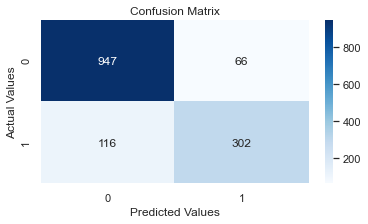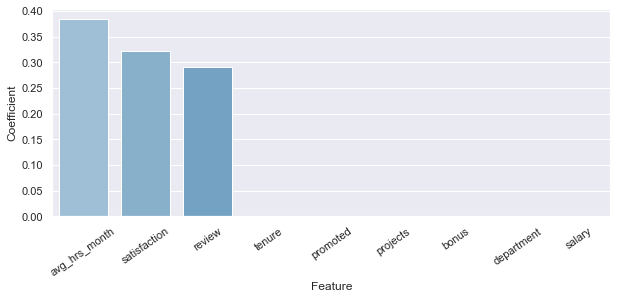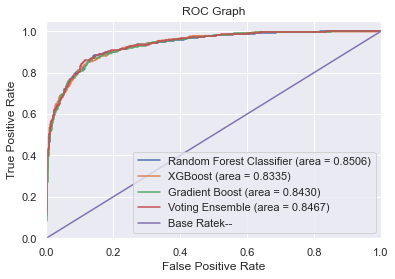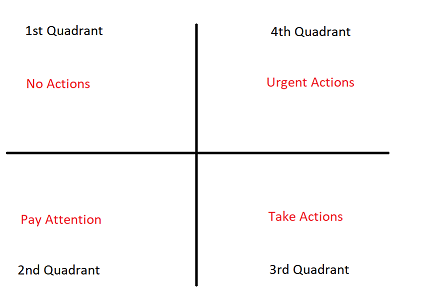Machine Learning, and the whole AI spectrum, give us a lot of resources to attack many common problems we have on a daily basis. The creation of the so-called ML 'models' give us powerful information: predictions.
Let's suppose we work for the HR team in a large company. The Board of the Company is worried about the relatively high turnover, and your team must look into ways to reduce the number of employees leaving the company. (This case is part of a DataCamp competition https://app.datacamp.com/workspace/w/fe01229f-0e67-47d8-8872-9eed8674da29)
The team needs to understand better the situation, which employees are more likely to leave, and why. Once it is clear what variables impact employee churn, you can present your findings along with your ideas on how to attack the concern. The department has assembled data on almost 10,000 employees. The team used information from exit interviews, performance reviews, and employee records. The variables we will find in the dataset for each employee are:
- Department - the department the employee belongs to.
- Promotion - if the employee was promoted in the previous 24 months.
- Review - the composite score the employee received in their last evaluation.
- Projects - how many projects the employee is involved in.
- Salary - for confidentiality reasons, salary comes in three tiers: low, medium, high.
- Tenure - how many years the employee has been at the company.
- Satisfaction - a measure of employee satisfaction from surveys.
- Average Worked Hours per Month - the average hours the employee worked in a month.
- Left - Whether the employee ended up leaving or not.
The analysis of the Data is a taks that must be tackle in phases. In this report, we will analyze three main premises:
- Which department has the highest employee turnover? Which one has the lowest? (Descriptive Analysis)
- Investigate which variables seem to be better predictors of employee departure. (Predictive Analysis)
- What recommendations would you make regarding ways to reduce employee turnover? (Prescriptive Analysis)
In the first point, Descriptive Analysis, we will answer the idea of 'What has happened?'. This is what we have done through all the Exploratory Analysis: understand what happened in the company, through the data. The value we learn here are the so-called 'hindsights'. In the second point, Predictive Analysis, we will reply to the idea of 'What could happen in the future based on previous trends and patterns?'. We will get the features (attributes/columns/characteristics) that are more relevant to define the outcome of the model. Then, we will generate the model. The value we learn here are the so-called 'insights'. In the third point, Prescriptive Analysis, we will reply to the idea of 'What should the company do?'. We have what happened in the past. We have the key features that define the behavior of the outcome. Now it's in our hands to try to anticipate the future and try to get the outcomes we are looking for. Here we apply the model, and we bring some business strategies into the 'game'. Here, the support from the Company's Direction is critical to get the most of the model's outcome. The value we learn here are the so-called 'foresights'.
Before starting with the first question, we will analyze the dataset to see if we can find insights. First, we will do an Exploratory Analysis by studying statistical data and correlations between the variables (in pairs). After this, we will do a Graphical Analysis. Moreover, we will continue analyzing pairs of data in a deeper way. Once we finish the analysis, we will release the first draft of the insights found.
Then, we will move to the first question, analyzing it from two different angles.
Regarding the second question, we will follow two different strategies, and then we will compare both of them. On one side, we will get the features following a specific Machine Learning Model, and we will generate the equation that allows us to forecast the outcome (if the employee leaves the company or not) using another ML Model. On the other hand, as a different approach, we will compare several ML algorithms, choosing the best three (following a specific scoring). Then, we will get the best features of each of these three models (and compare if they are the same ones like the ones we got from the previous point). After this, we will hyperparams tune each of the selected models to see if we can improve the scoring. Once this is finished, we will rank the final scores of the three algorithms again, and we will use the Voting model to see if the combination of them is better than using the best algorithm gotten. Then, we will try to get some predictions using some simulated data, and we will compare the results we got from both of the strategies followed.
Finally, in the last question, we will summarize all the studies done and get some general ideas to implement in the company. Also, in a more specific way, we will propose a strategy to follow based on a Command Board. Here the Human Resources team will be able to monitor and predict if and when they have to apply any kind of incentive or specific tool to avoid an employee leaving the company. This command board will measure the urgency of the case so no resources are wasted unnecessarily.
Importing
import warnings
warnings.filterwarnings('ignore')
import pandas as pd
import numpy as np
import math
import matplotlib.pyplot as plt
import seaborn as sns
sns.set_theme()
from pandas.plotting import scatter_matrixdf = pd.read_csv('./data/employee_churn_data.csv')
df.head()| department | promoted | review | projects | salary | tenure | satisfaction | bonus | avg_hrs_month | left | |
|---|---|---|---|---|---|---|---|---|---|---|
| 0 | operations | 0 | 0.577569 | 3 | low | 5.0 | 0.626759 | 0 | 180.866070 | no |
| 1 | operations | 0 | 0.751900 | 3 | medium | 6.0 | 0.443679 | 0 | 182.708149 | no |
| 2 | support | 0 | 0.722548 | 3 | medium | 6.0 | 0.446823 | 0 | 184.416084 | no |
| 3 | logistics | 0 | 0.675158 | 4 | high | 8.0 | 0.440139 | 0 | 188.707545 | no |
| 4 | sales | 0 | 0.676203 | 3 | high | 5.0 | 0.577607 | 1 | 179.821083 | no |
Data Exploration
df.info()<class 'pandas.core.frame.DataFrame'>
RangeIndex: 9540 entries, 0 to 9539
Data columns (total 10 columns):
# Column Non-Null Count Dtype
--- ------ -------------- -----
0 department 9540 non-null object
1 promoted 9540 non-null int64
2 review 9540 non-null float64
3 projects 9540 non-null int64
4 salary 9540 non-null object
5 tenure 9540 non-null float64
6 satisfaction 9540 non-null float64
7 bonus 9540 non-null int64
8 avg_hrs_month 9540 non-null float64
9 left 9540 non-null object
dtypes: float64(4), int64(3), object(3)
memory usage: 745.4+ KB
- We have 9540 entries, in 10 columns
- We have no NULL values and all the attributes seem to have the correct DataType
df.describe()| promoted | review | projects | tenure | satisfaction | bonus | avg_hrs_month | |
|---|---|---|---|---|---|---|---|
| count | 9540.000000 | 9540.000000 | 9540.000000 | 9540.000000 | 9540.000000 | 9540.000000 | 9540.000000 |
| mean | 0.030294 | 0.651826 | 3.274843 | 6.556184 | 0.504645 | 0.212055 | 184.661571 |
| std | 0.171403 | 0.085307 | 0.579136 | 1.415432 | 0.158555 | 0.408785 | 4.144831 |
| min | 0.000000 | 0.310000 | 2.000000 | 2.000000 | 0.000000 | 0.000000 | 171.374060 |
| 25% | 0.000000 | 0.592884 | 3.000000 | 5.000000 | 0.386801 | 0.000000 | 181.472085 |
| 50% | 0.000000 | 0.647456 | 3.000000 | 7.000000 | 0.500786 | 0.000000 | 184.628796 |
| 75% | 0.000000 | 0.708379 | 4.000000 | 8.000000 | 0.622607 | 0.000000 | 187.728708 |
| max | 1.000000 | 1.000000 | 5.000000 | 12.000000 | 1.000000 | 1.000000 | 200.861656 |
Statistical Summary
- Satisfaction: its mean is 50%
- Average Hours Worked per month: 184hs
- In most countries, the legal working schedule per day is (8+1)hs = 9hs. Monthly, this means 180hs.
- Here, we are saying that the mean is already above the legal number (above this number, the Company should extra compensate the employee). And, on top of that, the first 25th percentil already pass this quantity of hours. This means that more than 75% of the Company works more than what the law establishes (in a different description, we would have to analyze if the employee chose to do the overtime hours or if they have to, and if they are well retributed for these extra-hours or not. As this might impact on the employee's satisfaction)
- Promotion: Only 3% of the employees received any kind of promotion in the past two years.
- Years in the Company (tenure): the average time in the Company is 6.5 years.
- Bonus: Only 21% of the employees received any kind of Bonus.
- Projects: The average # of projects managed by an employee is 3.
df.left.value_counts()no 6756
yes 2784
Name: left, dtype: int64
sns.countplot(x='left', data=df)
plt.xticks(rotation=45)
plt.show()# Overview of summary (Turnover V.S. Non-turnover)
turnover_Summary = df.groupby('left')
turnOverSummaryMean=turnover_Summary.mean()
turnOverSummaryMean| promoted | review | projects | tenure | satisfaction | bonus | avg_hrs_month | |
|---|---|---|---|---|---|---|---|
| left | |||||||
| no | 0.034340 | 0.635164 | 3.279455 | 6.546625 | 0.505634 | 0.215068 | 184.637605 |
| yes | 0.020474 | 0.692262 | 3.263649 | 6.579382 | 0.502244 | 0.204741 | 184.719730 |
turnover_rate = df.left.value_counts() / df.shape[0]
turnover_rateno 0.708176
yes 0.291824
Name: left, dtype: float64
- Looks like about 71% of employees stayed and 29% of employees left.
Is there any correlation between the variables?
#For analysis purposes, we label-encode the target
dfNumeric=df.copy()
dfNumeric['leftNumeric']=0
dfNumeric.loc[dfNumeric['left']=='yes','leftNumeric']=1
dfNumeric.drop(columns='left',axis=1,inplace=True)
dfNumeric.rename(columns={'leftNumeric':'left'},inplace=True)
firstCol=dfNumeric.loc[:,'left']
restDF=dfNumeric.drop(columns='left',axis=1)
dfNumericCorr=pd.concat([firstCol,restDF], axis=1)corrmat = dfNumericCorr.corr()
corrmat = (corrmat)
f, ax = plt.subplots(figsize=(12,9))
sns.heatmap(corrmat, annot = True, vmax=.8, square=True)
plt.title('Heatmap of Correlation Matrix')
corrmat| left | promoted | review | projects | tenure | satisfaction | bonus | avg_hrs_month | |
|---|---|---|---|---|---|---|---|---|
| left | 1.000000 | -0.036777 | 0.304294 | -0.012408 | 0.010521 | -0.009721 | -0.011485 | 0.009008 |
| promoted | -0.036777 | 1.000000 | 0.001879 | 0.010107 | 0.001410 | -0.011704 | 0.001072 | -0.002190 |
| review | 0.304294 | 0.001879 | 1.000000 | 0.000219 | -0.184133 | -0.349778 | -0.003627 | -0.196096 |
| projects | -0.012408 | 0.010107 | 0.000219 | 1.000000 | 0.022596 | 0.002714 | 0.002654 | 0.021299 |
| tenure | 0.010521 | 0.001410 | -0.184133 | 0.022596 | 1.000000 | -0.146246 | -0.000392 | 0.978618 |
| satisfaction | -0.009721 | -0.011704 | -0.349778 | 0.002714 | -0.146246 | 1.000000 | 0.000704 | -0.143142 |
| bonus | -0.011485 | 0.001072 | -0.003627 | 0.002654 | -0.000392 | 0.000704 | 1.000000 | -0.000370 |
| avg_hrs_month | 0.009008 | -0.002190 | -0.196096 | 0.021299 | 0.978618 | -0.143142 | -0.000370 | 1.000000 |
dfNumeric.drop(columns='left',axis=1).corrwith(dfNumeric.loc[:,'left'])promoted -0.036777
review 0.304294
projects -0.012408
tenure 0.010521
satisfaction -0.009721
bonus -0.011485
avg_hrs_month 0.009008
dtype: float64
Positive Correlations:
- There is a strong positive relation between 'tenure' and 'avg_hrs_month.' This could mean that the longer the employee is in the company, the more hours he/she works.
- Also, there is a curious case in the relation between 'review' and 'left' as it looks like the higher the review, the higher the possibilities of leaving the company.
Negative Correlations:
- There is a low-level negative relation between 'review' and 'avg_hrs_month'. This might mean that the lower the review, the employees tend to work more hours.
- There is a negative relation between 'review' and 'satisfaction'. This means that the higher the review of the employee is, the lower the satisfaction is. This is strange, actually. Maybe the satisfaction level is not acquiring the real employees' satisfaction.
# Graph Employee Satisfaction
# Sort the dataframe by target
target_0 = dfNumeric[dfNumeric.left==0]
target_1 = dfNumeric[dfNumeric.left==1]
sns.distplot(target_0[['satisfaction']], rug=True,kde=False,label='Stayed')
sns.distplot(target_1[['satisfaction']], kde=False, rug=True,label='Left')
plt.title('Employees Satisfaction')
plt.legend()
plt.show()- The distribution tends to be a normal dist.
- The distribution of the employees who left it's 'inside' to the one of the employees who Stayed, but it is slightly right-skewed.
# Graph Employee Review
# Sort the dataframe by target
target_0 = dfNumeric[dfNumeric.left==0]
target_1 = dfNumeric[dfNumeric.left==1]
sns.distplot(target_0[['review']], rug=True,kde=False,label='Stayed')
sns.distplot(target_1[['review']], kde=False, rug=True,label='Left')
plt.title('Employees Review')
plt.legend()
plt.show()- The distribution of the employees who stayed tends to be a normal dist.
- The distribution of the employees who left it's left-skewed.
# Graph Employee avg_hrs_month
# Sort the dataframe by target
target_0 = dfNumeric[dfNumeric.left==0]
target_1 = dfNumeric[dfNumeric.left==1]
sns.distplot(target_0[['avg_hrs_month']], rug=True,kde=False,label='Stayed')
sns.distplot(target_1[['avg_hrs_month']], kde=False, rug=True,label='Left')
plt.title('Employees Average Hrs Worked per Month')
plt.legend()
plt.show()- Here, we see that the maximum values of Average Hours worked per Month belong to the employees who stayed.
- However, there is an important peak between 185 and 190 hours from the employees who left the company.
# scatter plot matrix
sns.set()
sns.pairplot(df, size = 2.5)
plt.show()ax = plt.subplots(figsize=(15, 4))
sns.countplot(x="salary", hue='left', data=df).set_title('Employee Salary Turnover')
plt.show()- There are no important remarks in regards to the Salary distribution
dfSalaryByDepartment=df
dfSalaryByDepartment['salaryNumeric'] = 0
dfSalaryByDepartment.loc[dfSalaryByDepartment['salary']=='medium','salaryNumeric']=1
dfSalaryByDepartment.loc[dfSalaryByDepartment['salary']=='high','salaryNumeric']=2
dfSalaryByDepartment=df.groupby(['department','salary','salaryNumeric']).count()/df.groupby(['department']).count()
dfSalaryByDepartment=dfSalaryByDepartment[['bonus']]
dfSalaryByDepartment.reset_index(inplace=True)
dfSalaryByDepartment.iloc[:,[0,1,3]]| department | salary | bonus | |
|---|---|---|---|
| 0 | IT | high | 0.165730 |
| 1 | IT | low | 0.120787 |
| 2 | IT | medium | 0.713483 |
| 3 | admin | high | 0.158392 |
| 4 | admin | low | 0.118203 |
| 5 | admin | medium | 0.723404 |
| 6 | engineering | high | 0.155013 |
| 7 | engineering | low | 0.134565 |
| 8 | engineering | medium | 0.710422 |
| 9 | finance | high | 0.174129 |
| 10 | finance | low | 0.144279 |
| 11 | finance | medium | 0.681592 |
| 12 | logistics | high | 0.141667 |
| 13 | logistics | low | 0.138889 |
| 14 | logistics | medium | 0.719444 |
| 15 | marketing | high | 0.167082 |
| 16 | marketing | low | 0.172070 |
| 17 | marketing | medium | 0.660848 |
| 18 | operations | high | 0.157687 |
| 19 | operations | low | 0.145204 |
| 20 | operations | medium | 0.697109 |
| 21 | retail | high | 0.161583 |
| 22 | retail | low | 0.149254 |
| 23 | retail | medium | 0.689163 |
| 24 | sales | high | 0.164631 |
| 25 | sales | low | 0.153478 |
| 26 | sales | medium | 0.681891 |
| 27 | support | high | 0.180952 |
| 28 | support | low | 0.133333 |
| 29 | support | medium | 0.685714 |
sns.barplot(x='department', y='bonus',hue='salary',data=dfSalaryByDepartment.sort_values(by='salaryNumeric')).set_title('Employee Department Quantity')
plt.xticks(rotation=90)
plt.show()totalPerDepartment=df.groupby(['department'])[['left']].count()
totalPerDepartment.rename(columns={'left':'totalEmployees'},inplace=True)
totalPerDepartment=totalPerDepartment.reset_index().sort_values(by='totalEmployees',ascending=False)
totalPerDepartment| department | totalEmployees | |
|---|---|---|
| 8 | sales | 1883 |
| 7 | retail | 1541 |
| 6 | operations | 1522 |
| 2 | engineering | 1516 |
| 5 | marketing | 802 |
| 9 | support | 735 |
| 1 | admin | 423 |
| 3 | finance | 402 |
| 4 | logistics | 360 |
| 0 | IT | 356 |
# Employee distribution
sns.barplot(x='department', y='totalEmployees',data=totalPerDepartment).set_title('Employee Department Quantity')
# Rotate x-labels
plt.xticks(rotation=90)
plt.show()numberOfLeftOver=dfNumeric.groupby('department')[['left']].sum()
totalPerDep=totalPerDepartment.rename(columns={'department':'departmentTotal'}).sort_values(by='departmentTotal')
numberOfLeftOver=numberOfLeftOver.reset_index().sort_values(by='left',ascending=False)
numberOfLeft2=numberOfLeftOver.sort_values(by='department')
departmentsDF=pd.concat([numberOfLeft2,totalPerDep],axis=1)
departmentsDF.drop(columns=['departmentTotal'],inplace=True)
departmentsDF['absoluteRatio']=departmentsDF['left']/departmentsDF['totalEmployees'].sum()
departmentsDF['relativeRatio']=departmentsDF['left']/departmentsDF['totalEmployees']
departmentsDF| department | left | totalEmployees | absoluteRatio | relativeRatio | |
|---|---|---|---|---|---|
| 0 | IT | 110 | 356 | 0.011530 | 0.308989 |
| 1 | admin | 119 | 423 | 0.012474 | 0.281324 |
| 2 | engineering | 437 | 1516 | 0.045807 | 0.288259 |
| 3 | finance | 108 | 402 | 0.011321 | 0.268657 |
| 4 | logistics | 111 | 360 | 0.011635 | 0.308333 |
| 5 | marketing | 243 | 802 | 0.025472 | 0.302993 |
| 6 | operations | 436 | 1522 | 0.045702 | 0.286465 |
| 7 | retail | 471 | 1541 | 0.049371 | 0.305646 |
| 8 | sales | 537 | 1883 | 0.056289 | 0.285183 |
| 9 | support | 212 | 735 | 0.022222 | 0.288435 |
f, ax = plt.subplots(figsize=(15, 5))
sns.countplot(x="department", hue='left', data=df).set_title('Employee Department Turnover')
plt.xticks(rotation=90)
plt.show()- The sales, retail, and engineering department were the top 3 employee turnover departments, in absolute numbers.
- In terms of TurnOver Ratio: IT is the first one, then logistics and then marketing.
- Why is it important also to consider the ratio? The sales department is the biggest one and had 537 persons who left the company (turnover ratio: 0.285183). This number is already bigger than the whole IT department, which had 110 employees who left the company. Now, taking into consideration that the total # of employees the IT department had was 356, the turnover ratio (0.308989) is bigger than the one from the sales department.
- The finance department had the smallest amount of turnover both in terms of absolute and relative levels.
Analyzing by Absolute Values/Ratio
dfNumeric[dfNumeric.department=='sales'].groupby('left').mean()| promoted | review | projects | tenure | satisfaction | bonus | avg_hrs_month | |
|---|---|---|---|---|---|---|---|
| left | |||||||
| 0 | 0.026746 | 0.635219 | 3.302377 | 6.546062 | 0.504261 | 0.220654 | 184.64599 |
| 1 | 0.026071 | 0.692769 | 3.245810 | 6.510242 | 0.505169 | 0.189944 | 184.54342 |
We see that, on average, the people who left the Company had a lower bonus than one who stayed, but a better review, which might mean they were good employees.
- The bigger the review is, the more the employees tend to leave the Company
dfNumeric[dfNumeric.department=='finance'].groupby('left').mean()| promoted | review | projects | tenure | satisfaction | bonus | avg_hrs_month | |
|---|---|---|---|---|---|---|---|
| left | |||||||
| 0 | 0.054422 | 0.637610 | 3.292517 | 6.384354 | 0.505762 | 0.227891 | 184.204821 |
| 1 | 0.027778 | 0.702093 | 3.296296 | 6.592593 | 0.473831 | 0.240741 | 184.838697 |
We see that the employees from Finance (the sector with the smallest turnover both in absolute and relative levels) who left the Company had the highest review than the ones who stayed, and also the biggest bonus, but they were less satisfied. Anyway, both groups have a bonus bigger than the Company's average one.
- Satisfaction level is important
- The bigger the review is, the more the employees tend to leave the Company
Analyzing by Relative Levels
Analyzing the employees from IT
dfNumeric[dfNumeric.department=='IT'].groupby('left').mean()| promoted | review | projects | tenure | satisfaction | bonus | avg_hrs_month | |
|---|---|---|---|---|---|---|---|
| left | |||||||
| 0 | 0.028455 | 0.631078 | 3.280488 | 6.589431 | 0.521494 | 0.223577 | 184.718036 |
| 1 | 0.009091 | 0.685021 | 3.309091 | 6.654545 | 0.503126 | 0.218182 | 185.051092 |
In terms of relative TurnOver, the employees who left the Company
- tended to work more hours per month.
- had a bigger review
- had been promoted a lot less
ax = sns.countplot(x="projects", hue="left", data=df)
plt.show()- No remarks from this analysis
turnOverSummaryMean| promoted | review | projects | tenure | satisfaction | bonus | avg_hrs_month | |
|---|---|---|---|---|---|---|---|
| left | |||||||
| no | 0.034340 | 0.635164 | 3.279455 | 6.546625 | 0.505634 | 0.215068 | 184.637605 |
| yes | 0.020474 | 0.692262 | 3.263649 | 6.579382 | 0.502244 | 0.204741 | 184.719730 |
target_0=df['left'] == 'no'
target_1=df['left'] == 'yes'# Kernel Density Plot
fig = plt.figure(figsize=(15,4),)
ax=sns.kdeplot(df.loc[(target_0),'review'] , color='b',shade=True,label='Stayed')
ax=sns.kdeplot(df.loc[(target_1),'review'] , color='r',shade=True, label='Left')
plt.title('Employee Review Distribution - Left the Company V.S. Stayed')
plt.legend()
plt.show()ax = sns.boxplot(x="left", y="review", data=df)Breaking the Analysis in Ranges
def splitRange(theDf,column,minValue,maxValue,numberOfSplits=0,theSteps=0):
"""This function receives a Dataframe, the column that you want to create Ranges from, the Starting Value, the Finishing Value
- the Number of Splits you would like to have, or the steps you would like your range to have.
The first 4 values are mandatory, and then you need to enter either of the last two values."""
if (theSteps==0) & (numberOfSplits==0):
print ('Enter the Number or Steps ot the Number of Splits.')
return
if numberOfSplits!=0:
theSteps=maxValue/numberOfSplits
for i in np.arange(minValue,maxValue,theSteps):
if i == minValue:
theDf.loc[(theDf[column]==i),column+'Range']=(str(np.round(i,1))+' - '+str(np.round(i+theSteps,1)))
theDf.loc[(theDf[column]>i) & (theDf[column]<=(i+theSteps)),column+'Range']=(str(np.round(i,1))+' - '+str(np.round(i+theSteps,1)))
if i+theSteps == maxValue:
theDf.loc[(theDf[column]==np.float(maxValue)),column+'Range']=(str(np.round(i,1))+' - '+str(np.round(i+theSteps,1)))
return theDftuenumberOfSplits=10
theColumn='review'
theMinValue=0
theMaxValue=1
rangedDf=splitRange(dfNumeric,theColumn,theMinValue,theMaxValue,tuenumberOfSplits)
rangedDf.sort_values(theColumn,inplace=True)sns.countplot(x='reviewRange',hue='left',data=rangedDf)
plt.xticks(rotation=45)
plt.show()rangedDf.groupby('reviewRange').mean()| promoted | review | projects | tenure | satisfaction | bonus | avg_hrs_month | left | |
|---|---|---|---|---|---|---|---|---|
| reviewRange | ||||||||
| 0.3 - 0.4 | 0.000000 | 0.366255 | 3.375000 | 7.500000 | 0.490251 | 0.000000 | 187.668970 | 0.375000 |
| 0.4 - 0.5 | 0.021127 | 0.471155 | 3.264085 | 6.866197 | 0.585176 | 0.225352 | 185.688096 | 0.211268 |
| 0.5 - 0.6 | 0.028187 | 0.562034 | 3.281027 | 6.720656 | 0.563554 | 0.214556 | 185.202270 | 0.191838 |
| 0.6 - 0.7 | 0.032474 | 0.648275 | 3.262178 | 6.651385 | 0.513817 | 0.207259 | 184.937028 | 0.213467 |
| 0.7 - 0.8 | 0.029770 | 0.740481 | 3.294542 | 6.428958 | 0.441698 | 0.220568 | 184.236939 | 0.448805 |
| 0.8 - 0.9 | 0.031042 | 0.832123 | 3.277162 | 5.283814 | 0.373368 | 0.199557 | 180.833566 | 0.802661 |
| 0.9 - 1.0 | 0.000000 | 0.921462 | 3.000000 | 4.600000 | 0.342033 | 0.133333 | 178.887824 | 0.933333 |
sns.scatterplot(x='review',y='tenure',hue='left',data=rangedDf)
plt.show()- The mean of the employees who left the company was 0.69.
- We can see that the higher the review score, the more chances the employee leave the company
- On top of that, employees with a review above 0.8 leave the company 90% of the time ((0.8+1)/2)
# Kernel Density Plot
fig = plt.figure(figsize=(15,4),)
ax=sns.kdeplot(df.loc[(target_0),'avg_hrs_month'] , color='b',shade=True,label='Stayed')
ax=sns.kdeplot(df.loc[(target_1),'avg_hrs_month'] , color='r',shade=True, label='Left')
plt.title('Employee Average Hours worked per Month Distribution - Left the Company V.S. Stayed')
plt.legend()
plt.show()- For the employees who stayed in the company, there is a right skewness: the mean is smaller than the median.
- For the employees who left the company, there is a clear left skewness. In this case, they tend to work many more hours than the average of the company.
- In fact, there is a big peak between 185 and 190 hours.
In general, in all the company the employees tend to do overtime hours.
total=df.groupby('left')[['department']].count()
overTimeHours=df[(df.avg_hrs_month>=185) & (df.avg_hrs_month<=190)]
overTimeHours.groupby('left')[['department']].count()/total| department | |
|---|---|
| left | |
| no | 0.304766 |
| yes | 0.569325 |
- 56% of the people who left the company were doing between 185 and 190 hs per month. This means between 9:15 and 9:30 hours per day.
Breaking the Analysis in Ranges
tuenumberOfSplits=0
theColumn='avg_hrs_month'
theMinValue=170
theMaxValue=205
steps=5
rangedDf=splitRange(dfNumeric,theColumn,theMinValue,theMaxValue,tuenumberOfSplits,steps)
rangedDf.sort_values(theColumn,inplace=True)sns.countplot(x='avg_hrs_monthRange',hue='left',data=rangedDf)
plt.xticks(rotation=45)
plt.show()rangedAVGDf=rangedDf.groupby('avg_hrs_monthRange').mean()
rangedAVGDf.reset_index(inplace=True)
rangedAVGDf| avg_hrs_monthRange | promoted | review | projects | tenure | satisfaction | bonus | avg_hrs_month | left | |
|---|---|---|---|---|---|---|---|---|---|
| 0 | 170 - 175 | 0.055556 | 0.760898 | 3.250000 | 2.916667 | 0.608214 | 0.138889 | 174.023432 | 0.583333 |
| 1 | 175 - 180 | 0.024942 | 0.687647 | 3.255651 | 4.558846 | 0.568620 | 0.208885 | 178.486336 | 0.303196 |
| 2 | 180 - 185 | 0.035946 | 0.658533 | 3.272432 | 5.790000 | 0.502061 | 0.213784 | 182.451945 | 0.207838 |
| 3 | 185 - 190 | 0.023600 | 0.635513 | 3.277168 | 7.477497 | 0.484191 | 0.212953 | 187.408187 | 0.434962 |
| 4 | 190 - 195 | 0.041514 | 0.633936 | 3.300366 | 8.932845 | 0.495071 | 0.207570 | 191.730056 | 0.024420 |
| 5 | 195 - 200 | 0.035088 | 0.643683 | 3.368421 | 10.403509 | 0.607906 | 0.210526 | 196.371355 | 0.000000 |
| 6 | 200 - 205 | 0.000000 | 0.513217 | 3.000000 | 12.000000 | 0.741743 | 1.000000 | 200.861656 | 0.000000 |
# Kernel Density Plot
fig = plt.figure(figsize=(15,4),)
ax=sns.kdeplot(df.loc[(target_0),'satisfaction'] , color='b',shade=True,label='Stayed')
ax=sns.kdeplot(df.loc[(target_1),'satisfaction'] , color='r',shade=True, label='Left')
plt.title('Employee Average Hours worked per Month Distribution - Left the Company V.S. Stayed')
plt.legend()
plt.show()- For the employees that stayed in the company, the distribution is slightly normal.
- However, for the employees who left the company, we can see a small right skewness, and we can see a peak below the mean.
Breaking the Analysis in Ranges
tuenumberOfSplits=10
theColumn='satisfaction'
theMinValue=0
theMaxValue=1
steps=0
rangedDf=splitRange(dfNumeric,theColumn,theMinValue,theMaxValue,tuenumberOfSplits,steps)#The database has a an error where the row 1755 has a Satisfaction of 1.0000000000000002, when it should be 1.
#With this line, we modify the error
theSatisfaction=df.iloc[1755].satisfaction
df.index[rangedDf['satisfaction']==theSatisfaction]
rangedDf.iloc[9539,12]='0.9 - 1.0'rangedDf.sort_values('satisfaction',inplace=True)sns.countplot(x='satisfactionRange',hue='left',data=rangedDf)
plt.xticks(rotation=45)
plt.show()rangedDf.groupby('satisfactionRange').mean()| promoted | review | projects | tenure | satisfaction | bonus | avg_hrs_month | left | |
|---|---|---|---|---|---|---|---|---|
| satisfactionRange | ||||||||
| 0.0 - 0.1 | 0.000000 | 0.658469 | 3.150000 | 4.950000 | 0.065175 | 0.150000 | 179.804302 | 0.100000 |
| 0.1 - 0.2 | 0.048913 | 0.677829 | 3.331522 | 5.842391 | 0.165406 | 0.163043 | 182.522148 | 0.222826 |
| 0.2 - 0.3 | 0.031335 | 0.675027 | 3.267030 | 6.422343 | 0.260044 | 0.211172 | 184.250908 | 0.262943 |
| 0.3 - 0.4 | 0.027284 | 0.679509 | 3.263938 | 6.730130 | 0.353393 | 0.218268 | 185.198822 | 0.332740 |
| 0.4 - 0.5 | 0.030545 | 0.674496 | 3.280075 | 7.003759 | 0.449812 | 0.209117 | 185.965055 | 0.303102 |
| 0.5 - 0.6 | 0.037924 | 0.655816 | 3.277445 | 6.787924 | 0.548742 | 0.226048 | 185.285040 | 0.283433 |
| 0.6 - 0.7 | 0.031843 | 0.624374 | 3.272505 | 6.189835 | 0.647976 | 0.195346 | 183.606978 | 0.261482 |
| 0.7 - 0.8 | 0.016667 | 0.592276 | 3.270000 | 5.877778 | 0.741373 | 0.216667 | 182.767080 | 0.306667 |
| 0.8 - 0.9 | 0.009050 | 0.550986 | 3.307692 | 5.601810 | 0.840572 | 0.230769 | 181.857086 | 0.294118 |
| 0.9 - 1.0 | 0.034483 | 0.517315 | 3.275862 | 5.620690 | 0.925911 | 0.137931 | 181.722800 | 0.206897 |
#The database has a an error where the row 1755 has a Satisfaction of 1.0000000000000002, when it should be 1.
#With this line, we modify the error
theSatisfaction=df.iloc[1755].satisfaction
df.index[rangedDf['satisfaction']==theSatisfaction]
rangedDf.iloc[9539,12]='0.9 - 1.0'sns.lineplot(x='reviewRange',y='tenure',data=rangedDf.sort_values('review'))
plt.xticks(rotation=45)
plt.show()- The bigger the satisfaction is, the lower the review is. And vice versa.
sns.scatterplot(x='satisfaction',y='review',hue='left',data=df)
plt.show()In terms of employees who left the company, we find two distinctive clusters:
- Employees with low satisfaction and high review: those might have been good employees but not happy in the company.
- Most of the employees who left were grouped with a satisfaction above the mean and with an average review.
f, ax = plt.subplots(figsize=(15, 5))
sns.countplot(x="tenure", hue='left', data=df).set_title('Employee years in the company Turnover')
plt.show()f, ax = plt.subplots(figsize=(15, 5))
sns.barplot(x="tenure", y="tenure", hue="left", data=df, estimator=lambda x: len(x) / len(df) * 100)
ax.set(ylabel="Percent")
plt.show()- We see that in the years 3 & 4, and 7 & 8 years in the company, the turnover ratio almost reaches a parity.
- However, due to statistical significance, I would pay special attention to the years 7 and 8
- This might mean that some of the employees who left the company might have been headhunted.
sns.lineplot(x='avg_hrs_month',y='tenure',hue='left',data=df)
plt.xticks(rotation=45)
plt.show()- Both the employees who stay as the ones who left tend to work more as they have a bigger tenure (more years in the company)
sns.lineplot(x='reviewRange',y='tenure',data=rangedDf.sort_values('review'))
plt.xticks(rotation=45)
plt.show()- Also, we see that the employees who got the higher reviews were the employees with fewer years in the company
- The unique indicator found that directly (and clearly) impacts the outcome (if the employee leaves the Company or not) is the Review of the Employee. The higher the review, the more chances the employee has to leave the Company.
- Linked to the Review indicator, we have the Satisfaction, as higher the review is, the lower the Satisfaction is (it's almost a perfect negative relation with the exception of the first Satisfaction's ranges).
Statistical Summary
- Satisfaction: its mean is 50%.
- Average Hours Worked per month: 184hs
- Promotion: Only 3% of the employees received any kind of promotion in the past two years.
- Years in the Company (tenure): the average time in the Company is 6.5 years.
- Bonus: Only 21% of the employees received any kind of Bonus.
- Projects: The average # of projects managed by an employee is 3.
- Review:
- Employees with a review above 0.8 leave the Company 90% of the times
- Employees who got the higher reviews were the employees with fewer years in the Company
TurnOver:
- about 71% of employees stayed, and 29% of employees left the Company in the last analyzed period.
Correlations
-
Positive Correlations:
- There is a strong positive relation between 'tenure' and 'avg_hrs_month'. This could mean that the longer the employee is in the Company, the more hours he/she works.
- Also, there is a curious case in the relation between 'review' and 'left' as it looks like the higher the review, the higher the possibilities of leaving the Company.
-
Negative Correlations:
- There is a low-level negative relation between 'review' and 'avg_hrs_month'. This might mean that the lower the review, the employees tend to work more hours.
- There is a negative relation between 'review' and 'satisfaction'. This means that the higher the review of the employee is, the lower the Satisfaction is. This is strange, actually. Maybe the satisfaction level is not acquiring the real employees' Satisfaction.
ANALYSIS OF THE EMPLOYEES FROM SALES We see that, on average, the people who left the Company had a lower bonus than one who stayed, but a better review, which might mean they were good employees.
ANALYSIS OF THE EMPLOYEES FROM FINANCES We see that the employees from Finance (the sector with the smallest turnover both in absolute and relative levels) who left the Company had the highest review than the ones who stayed, and also the biggest Bonus, but they were less satisfied. Anyway, both groups had a bonus bigger than the Company's average one.
ANALYSIS OF THE EMPLOYEES FROM IT In terms of relative TurnOver, the employees who left the Company:
- tended to work more hours per month.
- had a bigger review
- had been promoted a lot less
departmentsDF| department | left | totalEmployees | absoluteRatio | relativeRatio | |
|---|---|---|---|---|---|
| 0 | IT | 110 | 356 | 0.011530 | 0.308989 |
| 1 | admin | 119 | 423 | 0.012474 | 0.281324 |
| 2 | engineering | 437 | 1516 | 0.045807 | 0.288259 |
| 3 | finance | 108 | 402 | 0.011321 | 0.268657 |
| 4 | logistics | 111 | 360 | 0.011635 | 0.308333 |
| 5 | marketing | 243 | 802 | 0.025472 | 0.302993 |
| 6 | operations | 436 | 1522 | 0.045702 | 0.286465 |
| 7 | retail | 471 | 1541 | 0.049371 | 0.305646 |
| 8 | sales | 537 | 1883 | 0.056289 | 0.285183 |
| 9 | support | 212 | 735 | 0.022222 | 0.288435 |
departmentsDF['absoluteRatio'].plot(label = 'Internal Ratio: Deparment Left / Department Original', figsize = (15,7))
departmentsDF['relativeRatio'].plot(label = "Internal TurnOver: Department Left / (Department Original+Department Final)/2")
plt.title('Ratios vs TurnOvers')
plt.legend()
xticks=[i for i in range(len(departmentsDF['department']))]
xlabelsNames=[i for i in departmentsDF['department']]
plt.xticks(xticks, xlabelsNames)
plt.show()As we can see in this graphic, depending the ratio that it is taken as parameter, the result will change.
- The Sales, Retail, and Engineering departments were the top 3 employee turnover departments, in absolute numbers.
- In terms of TurnOver Ratio: IT is the first one, then logistics and then marketing.
- Why is it important also to consider the ratio? Sales are the biggest department in the company (1883 employees) and had 537 employees who left the company (turnover ratio: 0.285). This number is already bigger than the whole IT department (356 employees), who had 110 employees who left the company, with a result of a turnover ratio of 0.308, bigger than the one from the sales department.
- The finance department had the smallest amount of turnover both in terms of absolute and relative levels.
print('The department with the highest number of Employees Internal TurnOver is (the department comparing against itself): {}'.format(departmentsDF.iloc[departmentsDF.relativeRatio.idxmax(),0]))
print('The department with the highest number of Employees Total TurnOver is (the department comparing against the whole company): {}'.format(departmentsDF.iloc[departmentsDF.absoluteRatio.idxmax(),0]))The department with the highest number of Employees Internal TurnOver is (the department comparing against itself): IT
The department with the highest number of Employees Total TurnOver is (the department comparing against the whole company): sales
print('The department with the lowest number of Employees Internal TurnOver is (the department comparing against itself): {}'.format(departmentsDF.iloc[departmentsDF.relativeRatio.idxmin(),0]))
print('The department with the lowest number of Employees Total TurnOver is (the department comparing against the whole company): {}'.format(departmentsDF.iloc[departmentsDF.relativeRatio.idxmin(),0]))The department with the lowest number of Employees Internal TurnOver is (the department comparing against itself): finance
The department with the lowest number of Employees Total TurnOver is (the department comparing against the whole company): finance
For modeling a Machine Learning algorithm, first of all, we need to identify the problem we are in: in this case, it's a classification problem (the outcome we are expecting is a specific value included in a defined range of possible values). Here is 'yes' or 'no'. The employee leaves the company or not.
Then, what algorithm should we use? Well, no one has the answer. It depends on many factors. That is why, in point 2.2, we will be trying a set of them and see which one scores the better.
For modeling ML's algorithms, the data also has to fulfill some conditions. One of them is that all the data has only numeric values. That is why we need to convert all the non-numerical values into numbers. This will be the case of the target/outcome ('yes' or 'no', will be converted into 1 or 0) and the departments ('sales', 'it', 'finance'... which will be converted in 0,1,2,3,...). On top of this, the dataset must not have any NULL value. However, we have already checked that, and we are OK.
In the ML modeling, we will have to split our dataset into train and test sets. The train set will be composed of 85% of the total dataset, while the 15% rest will be the test one. Why? Because we will have to evaluate how well our model did in the training phase. After splitting our dataset, will have to 'fit' a model (also known as 'estimator') to a training dataset. Then, once we have tuned the model's parameters to make it score better, we apply the fitted model to the dataset we will use to predict. Once we have the predictions, we will compare them with the actual results of the test set, to see how good we did. We will repeat this procedure (tuning, predicting & scoring) until we have the best possible result.
For selecting the Variables/Features that would explain our model, we have two options:
- We select the features by using a Classification Model and then apply these best features in a Logistic Regression Model
- We can use other models and compare their accuracy. Then we pick the best model, extract the most important features (according to that model), hyperparams tune it, and see if the final score is better than the previous one.
2.1. Option 1: We will select the Most Important Features by applying the Decision Tree Classifier Model (CART), and then apply the Logistic Regression Model in order to obtain the equation (model) that predict the outcome.
import warnings
warnings.filterwarnings('ignore')
# Import the neccessary modules for data manipulation and visual representation
import pandas as pd
import numpy as np
import matplotlib.pyplot as plt
import matplotlib as matplot
import seaborn as sns
#Read the analytics csv file and store our dataset into a dataframe called "df"
from sklearn.linear_model import LogisticRegression
from sklearn.preprocessing import LabelEncoder
from sklearn.model_selection import train_test_split
from sklearn.metrics import accuracy_score, classification_report, precision_score, recall_score, confusion_matrix, precision_recall_curve
from sklearn.preprocessing import RobustScaler
df = pd.read_csv('./data/employee_churn_data.csv')
#We label-encode the target
labelencoder_y = LabelEncoder()
df['left'] = labelencoder_y.fit_transform(df.left)
# Convert these variables into categorical variables
df["department"] = df["department"].astype('category').cat.codes
df["salary"] = df["salary"].astype('category').cat.codes#We create a Validation set - Split-out validation dataset
#The columns are removed and only that data is taken
#We take the name of the features, excluding the target.
target_name = 'left'
namesFeatures=df.drop(columns=target_name).columns.values
array = df.values
X = array[:,0:-1]
y = array[:,-1]
# split into 85:15 ration
validation_size = 0.15
seed = 7
X_train, X_test, y_train, y_test = train_test_split(X, y, test_size=validation_size, random_state=seed,stratify=y)Here we will select the most important Features
from sklearn import tree
from sklearn.tree import DecisionTreeClassifier
from sklearn.model_selection import train_test_split
# Create train and test splits
target_name = 'left'
model = tree.DecisionTreeClassifier(
#max_depth=3,
class_weight="balanced",
min_weight_fraction_leaf=0.01
)
dtree = model.fit(X_train,y_train)
## plot the importances ##
importances = dtree.feature_importances_
feat_names = df.drop(['left'],axis=1).columns
# Get the models coefficients (and top 5)
coeff = pd.DataFrame({'feature_name': feat_names, 'model_coefficient': importances.transpose().flatten()})
coeff = coeff.sort_values('model_coefficient',ascending=False)
coeff_top = coeff.head(10)
coeff_bottom = coeff.tail(10)
# Plot top 5 coefficients
plt.figure().set_size_inches(10, 6)
fg3 = sns.barplot(x='feature_name', y='model_coefficient',data=coeff_top, palette="Blues_d")
fg3.set_xticklabels(rotation=35, labels=coeff_top.feature_name)
plt.xlabel('Feature')
plt.ylabel('Coefficient')
plt.show()theDf = {'Name':feat_names, 'Ranking':importances}
tableFeatures = pd.DataFrame(theDf)
tableFeatures.sort_values(by='Ranking',ascending=False,inplace=True)
selectedFeatures=tableFeatures.Name.head(3)
tableFeatures.head(5)| Name | Ranking | |
|---|---|---|
| 8 | avg_hrs_month | 0.459562 |
| 2 | review | 0.289989 |
| 6 | satisfaction | 0.247966 |
| 0 | department | 0.002482 |
| 1 | promoted | 0.000000 |
According to the features' ranking obtained by applying the Decision Tree Classifier, these are the Top 3 features:
- avg_hrs_month
- review
- satisfaction
We will select and apply them in the next Logistic Regression model to create the equation to predict future outcomes.
# Create an intercept term for the logistic regression equation
target_name = 'left'
namesFeatures=df.drop(columns=target_name).columns.values
#We create the Intercept 'dummy' variable now.
df['intercept'] = 1
indep_var = [i for i in selectedFeatures]
df = df[indep_var+['intercept',target_name]]
# Create train and test splits
X = df.drop(target_name, axis=1)
y=df[target_name]
X_train, X_test, y_train, y_test = train_test_split(X,y,test_size=0.15, random_state=123, stratify=y)import statsmodels.api as sm
model = sm.Logit(y_train, X_train[indep_var+['intercept']],random_state=7)
answer = model.fit()
print(answer.summary())
answer.paramsOptimization terminated successfully.
Current function value: 0.543203
Iterations 6
Logit Regression Results
==============================================================================
Dep. Variable: left No. Observations: 8109
Model: Logit Df Residuals: 8105
Method: MLE Df Model: 3
Date: Sun, 16 Jan 2022 Pseudo R-squ.: 0.1003
Time: 14:44:27 Log-Likelihood: -4404.8
converged: True LL-Null: -4895.7
Covariance Type: nonrobust LLR p-value: 1.700e-212
=================================================================================
coef std err z P>|z| [0.025 0.975]
---------------------------------------------------------------------------------
avg_hrs_month 0.0617 0.006 9.488 0.000 0.049 0.074
review 11.1047 0.392 28.347 0.000 10.337 11.872
satisfaction 2.4885 0.201 12.359 0.000 2.094 2.883
intercept -20.8979 1.345 -15.540 0.000 -23.534 -18.262
=================================================================================
avg_hrs_month 0.061653
review 11.104666
satisfaction 2.488504
intercept -20.897861
dtype: float64
The equation would be:
Employee Turnover Score = avg_hrs_month*(0.061653) + review*(11.104666) + satisfaction*(2.488504) - 20.897861
An example of the information we could get from this would be the following: (in the last chapter we will go deeper)
# Create function to compute coefficients
coef = answer.params
def theAlarm(value):
if (value >=0) & (value <0.25):
toReturn='\n The Employee is in the 1st Quadrant. \x1b[6;30;42m' + 'No actions should be taken.' + '\x1b[0m'
return (toReturn)
elif (value >=0.25) & (value <0.50):
toReturn='\n The Employee is in the 2nd Quadrant. \x1b[0;30;46m' + 'Pay attention to the employee.' + '\x1b[0m'
return (toReturn)
elif (value >=0.50) & (value <0.75):
toReturn='\n The Employee is in the 3rd Quadrant. \x1b[0;30;43m' + 'Actions should be taken.' + '\x1b[0m'
return (toReturn)
else:
toReturn='\n The Employee is in the 4th Quadrant. \x1b[0;37;41m' + 'Urgent Actions must be taken!' + '\x1b[0m'
return (toReturn)
def getTurnOver (coef, avg_hrs_month, review, satisfaction) :
y = coef[3] + coef[0]*avg_hrs_month + coef[1]*review + coef[2]*satisfaction
p = np.exp(y) / (1+np.exp(y))
quadrant=theAlarm(p)
print ('The Employee is working: {} Hours in Average per Month, has Review of: {}%, and has a Satisfaction level of: {}%. \nThis Employee has {}% chances of leaving the company. {}'.format(avg_hrs_month,review*100,satisfaction*100,np.round(p*100,1),quadrant))# An Employee with 70% of Satisfaction, 50% of Review, that worked 170 hours in average per month.
averageOverHours=170
review=0.5
satisfaction=0.8
getTurnOver(coef, averageOverHours, review, satisfaction)The Employee is working: 170 Hours in Average per Month, has Review of: 50.0%, and has a Satisfaction level of: 80.0%.
This Employee has 5.3% chances of leaving the company.
The Employee is in the 1st Quadrant. �[6;30;42mNo actions should be taken.�[0m
2.2. Option 3: We will rank the scoring of some Machine Learning Classification algorithms according to their respective ROC-AUC in the train set, pick the best one, get the coefficients (most important features), hyperparams tune it, and the final model.
For this process, we will use:
- Cross-Validation: Cross-validation is a technique for evaluating a machine learning model and testing its performance.
- With Kfold: k-Fold CV is a technique that minimizes the disadvantages of the hold-out method.
- ROC-AUC Score: ROC Curves summarize the trade-off between the true positive rate and false-positive rate for a predictive model using different probability thresholds.
- We cannot use Accuracy (to test the Accuracy) as we are in an imbalanced-binary-output dataset. False Positive and False Negative errors must be considered, and Accuracy alone does not measure them.
# Load libraries
from sklearn import linear_model
#Cross Validation Techniques
from sklearn.model_selection import KFold
from sklearn.model_selection import RepeatedStratifiedKFold
from sklearn.model_selection import cross_val_score
from sklearn.model_selection import GridSearchCV
from sklearn.metrics import classification_report
from sklearn.metrics import confusion_matrix
from sklearn.metrics import accuracy_score
from sklearn.metrics import roc_auc_score
#Classifier
from sklearn.linear_model import LogisticRegression
from sklearn.tree import DecisionTreeClassifier
from sklearn.neighbors import KNeighborsClassifier
from sklearn.discriminant_analysis import LinearDiscriminantAnalysis
from sklearn.naive_bayes import GaussianNB
from sklearn.svm import SVC
#Ensemble
from sklearn.ensemble import AdaBoostClassifier
from sklearn.ensemble import GradientBoostingClassifier
from sklearn.ensemble import RandomForestClassifier
from sklearn.ensemble import ExtraTreesClassifier
from sklearn.ensemble import BaggingClassifier
from xgboost import XGBClassifierdf = pd.read_csv('./data/employee_churn_data.csv')
#We label-encode the target
labelencoder_y = LabelEncoder()
df['left'] = labelencoder_y.fit_transform(df.left)
# Convert these variables into categorical variables
df["department"] = df["department"].astype('category').cat.codes
df["salary"] = df["salary"].astype('category').cat.codes
#We create a Validation set - Split-out validation dataset
#The columns are removed and only that data is taken
#We take the name of the features, excluding the target.
target_name = 'left'
namesFeatures=df.drop(columns=target_name).columns.values
array = df.values
X = array[:,0:-1]
y = array[:,-1]
# split into 85:15 ration
validation_size = 0.15
seed = 7
X_train, X_test, y_train, y_test = train_test_split(X, y, test_size=validation_size, random_state=seed,stratify=y)num_folds = 5
seed = 7
number_repeats = 3
scoring='roc_auc'
#Select 1 for KFold, 2 for RepeatedStratifiedKFold
cvToUse=1
if cvToUse==1:
cv = KFold( n_splits=num_folds,
shuffle=True,
random_state=seed
)
else:
cv = RepeatedStratifiedKFold( n_splits=num_folds,
n_repeats=number_repeats,
random_state=seed
)# Spot-Check Algorithms
models = []
models.append(('LR', LogisticRegression(random_state=seed)))
models.append(('LDA', LinearDiscriminantAnalysis())) #Doesn't allow random_state
models.append(('KNN', KNeighborsClassifier())) #Doesn't allow random_state
models.append(('CART', DecisionTreeClassifier(random_state=seed)))
models.append(('NB', GaussianNB())) #Doesn't allow random_state
models.append(('SVM', SVC(random_state=seed)))
# ensembles
models.append(('BDT-Ensemble', BaggingClassifier(random_state=seed)))
models.append(('AB-Ensemble', AdaBoostClassifier(random_state=seed)))
models.append(('GBC-Ensemble', GradientBoostingClassifier(random_state=seed)))
models.append(('XGB-Ensemble', XGBClassifier(random_state=seed,eval_metric='logloss'))) #I set this eval_metric for avoiding warning messages.
models.append(('RF-Ensemble', RandomForestClassifier(random_state=seed)))
models.append(('ET-Ensemble', ExtraTreesClassifier(random_state=seed)))
# evaluate each model in turn
resultsSimpler = []
namesSimpler = []
# Create DataFrame
tableResults = pd.DataFrame(columns=['Name', 'ROC-AUC(Train)', 'STD'])
print("Scoring used: ROC-AUC")
for name, model in models:
cv_results = cross_val_score(model, X_train, y_train, cv=cv, scoring=scoring)
resultsSimpler.append(cv_results)
namesSimpler.append(name)
new_row = {'Name':name, 'ROC-AUC(Train)':cv_results.mean(), 'STD':cv_results.std()}
tableResults = tableResults.append(new_row, ignore_index=True)
msg = "{}: {} ({})".format(name, cv_results.mean(), cv_results.std())
print(msg)
tableResults=tableResults.sort_values(by='ROC-AUC(Train)',ascending=False)
tableResults
Scoring used: ROC-AUC
LR: 0.6939307985118056 (0.015222599204236527)
LDA: 0.7189424885547057 (0.015509742665182055)
KNN: 0.7308053397060327 (0.0077046622782576835)
CART: 0.7855039148935751 (0.009134661911484994)
NB: 0.7127441184325531 (0.012938366031042732)
SVM: 0.61157105872254 (0.01786056670182524)
BDT-Ensemble: 0.9055489950151159 (0.004911097629818087)
AB-Ensemble: 0.8482198674988943 (0.0037887496497835365)
GBC-Ensemble: 0.9204620061188449 (0.004513217863409023)
XGB-Ensemble: 0.9219059521732735 (0.006389556574612421)
RF-Ensemble: 0.9250010593808922 (0.00569482185845855)
ET-Ensemble: 0.9154081004321297 (0.005482901806565513)
| Name | ROC-AUC(Train) | STD | |
|---|---|---|---|
| 10 | RF-Ensemble | 0.925001 | 0.005695 |
| 9 | XGB-Ensemble | 0.921906 | 0.006390 |
| 8 | GBC-Ensemble | 0.920462 | 0.004513 |
| 11 | ET-Ensemble | 0.915408 | 0.005483 |
| 6 | BDT-Ensemble | 0.905549 | 0.004911 |
| 7 | AB-Ensemble | 0.848220 | 0.003789 |
| 3 | CART | 0.785504 | 0.009135 |
| 2 | KNN | 0.730805 | 0.007705 |
| 1 | LDA | 0.718942 | 0.015510 |
| 4 | NB | 0.712744 | 0.012938 |
| 0 | LR | 0.693931 | 0.015223 |
| 5 | SVM | 0.611571 | 0.017861 |
We can see that with the Logistic Regression model, we are around 69% of Roc-Auc in the train-set, which is not a good score, but it is acceptable. When testing the model against the Test set, the score might drop; however, with some tune in the algorithm's hyperparameters, we could make the score increase again. Nevertheless, we can establish that our predictions (outcome) in the last step will be around that score. In this case, we will try to improve the score with other models.
We will select the first three best-scored algorithms:
tableResults.head(3)| Name | ROC-AUC(Train) | STD | |
|---|---|---|---|
| 10 | RF-Ensemble | 0.925001 | 0.005695 |
| 9 | XGB-Ensemble | 0.921906 | 0.006390 |
| 8 | GBC-Ensemble | 0.920462 | 0.004513 |
tunedAlgorithmTable = pd.DataFrame(columns=['Name', 'ROC-AUC(Test)','Model','BestEstimator'])rfc = RandomForestClassifier(random_state=seed)
rfc.fit(X_train, y_train)
# estimate accuracy on validation dataset
predictions = rfc.predict(X_test)
print('The Initial Model ROC-AUC on the Test Set is:')
rfc_roc_auc = roc_auc_score(y_test, predictions)
print(rfc_roc_auc)
## Take the important Features ##
importances = rfc.feature_importances_
cm=confusion_matrix(y_test, predictions)
plt.figure(figsize=(6,3))
plt.title("Confusion Matrix")
sns.heatmap(cm, annot=True,fmt='d', cmap='Blues')
plt.ylabel("Actual Values")
plt.xlabel("Predicted Values")
plt.show()The Initial Model ROC-AUC on the Test Set is:
0.8296546805405329
According to RFC, the most important features to explain the model are:
from sklearn.feature_selection import SelectFromModel
numbers=pd.Series(np.arange(0,len(importances)))
values=pd.Series(importances)
newDF=pd.DataFrame({'id':numbers,'value':values})
newDF.sort_values(by='value',ascending=False,inplace=True)
selectModel = SelectFromModel(rfc, prefit=True)
X_train_new = selectModel.transform(X_train)
X_test_new = selectModel.transform(X_test)
newQuantityOfFeatures=X_train_new.shape[1]
newDF=newDF.iloc[0:newQuantityOfFeatures,:]
theIds=newDF[newDF['value'] == [i for i in newDF.value]].id
selectedFeatures=theIds.values
theDf = {'Name':namesFeatures, 'Ranking':importances}
tableFeatures = pd.DataFrame(theDf)
tableFeatures.sort_values(by='Ranking',ascending=False,inplace=True)
tableFeatures.head(len(theIds))| Name | Ranking | |
|---|---|---|
| 6 | satisfaction | 0.289346 |
| 8 | avg_hrs_month | 0.264938 |
| 2 | review | 0.261772 |
# Get the models coefficients
coeff = pd.DataFrame({'feature_name': namesFeatures, 'model_coefficient': importances.transpose().flatten()})
coeff = coeff.sort_values('model_coefficient',ascending=False)
coeff_top = coeff.head(10)
coeff_bottom = coeff.tail(10)
plt.figure().set_size_inches(10, 6)
fg3 = sns.barplot(x='feature_name', y='model_coefficient',data=coeff_top, palette="Blues_d")
fg3.set_xticklabels(rotation=35, labels=coeff_top.feature_name)
plt.xlabel('Feature')
plt.ylabel('Coefficient')
plt.subplots_adjust(bottom=0.4)As we can see, the Random Forest Model returns the same three features as the Logistic Regression did but is weighted differently. In this case, the order is:
- Satisfaction
- Average Working Hours per Month
- Review
Tuning RFC
# define models
rfc = RandomForestClassifier(random_state=seed)
param_grid = {'n_estimators' : [1100],
"min_samples_split" : [11],
'class_weight':["balanced"],
'max_depth': [None],
'random_state':[seed],
# 'max_features':['sqrt', 'log2'],
'min_samples_leaf': [1]
}
grid_search = GridSearchCV( estimator=rfc,
param_grid=param_grid,
n_jobs=-1,
cv=cv,
scoring=scoring
)
grid_result = grid_search.fit(X_train, y_train)
# summarize results
print("Best: %f using %s" % (grid_result.best_score_, grid_result.best_params_))
print('Best Estimator: ',grid_result.best_estimator_)
best_hyperparams=grid_result.best_params_
best_cv_score=grid_result.best_score_Best: 0.928198 using {'class_weight': 'balanced', 'max_depth': None, 'min_samples_leaf': 1, 'min_samples_split': 11, 'n_estimators': 1100, 'random_state': 7}
Best Estimator: RandomForestClassifier(class_weight='balanced', min_samples_split=11,
n_estimators=1100, random_state=7)
#model
rfc = RandomForestClassifier(**grid_result.best_params_)
# Estimate accuracy on validation dataset
rfc.fit(X_train, y_train)
predictions = rfc.predict(X_test)
print('The FINAL Model ROC-AUC score on the Test Set is: ')
rfc_roc_auc = roc_auc_score(y_test, predictions)
print(rfc_roc_auc)
print(confusion_matrix(y_test, predictions))
new_row = { 'Name':'RF-Ensemble',
'ROC-AUC(Test)':roc_auc_score(y_test, predictions),
'Model':rfc,
'BestEstimator':grid_result.best_estimator_}
tunedAlgorithmTable = tunedAlgorithmTable.append(new_row, ignore_index=True)The FINAL Model ROC-AUC score on the Test Set is:
0.8505989126994999
[[926 87]
[ 89 329]]
from xgboost import XGBClassifier
from sklearn.metrics import confusion_matrix
xgb = XGBClassifier(random_state=seed,eval_metric='logloss')
xgb.fit(X_train, y_train)
# estimate accuracy on validation dataset
predictions = xgb.predict(X_test)
print('The Initial Model ROC-AUC on the Test Set is:')
xgb_roc_auc = roc_auc_score(y_test, predictions)
print(xgb_roc_auc)
## Take the important Features ##
importances = xgb.feature_importances_
cm=confusion_matrix(y_test, predictions)
plt.figure(figsize=(6,3))
plt.title("Confusion Matrix")
sns.heatmap(cm, annot=True,fmt='d', cmap='Blues')
plt.ylabel("Actual Values")
plt.xlabel("Predicted Values")
plt.show()The Initial Model ROC-AUC on the Test Set is:
0.8280983577133626
According to XGB, the most important features to explain the model are:
from sklearn.feature_selection import SelectFromModel
numbers=pd.Series(np.arange(0,len(importances)))
values=pd.Series(importances)
newDF=pd.DataFrame({'id':numbers,'value':values})
newDF.sort_values(by='value',ascending=False,inplace=True)
selectModel = SelectFromModel(xgb, prefit=True)
X_train_new = selectModel.transform(X_train)
X_test_new = selectModel.transform(X_test)
newQuantityOfFeatures=X_train_new.shape[1]
newDF=newDF.iloc[0:newQuantityOfFeatures,:]
theIds=newDF[newDF['value'] == [i for i in newDF.value]].id
selectedFeatures=theIds.values
theDf = {'Name':namesFeatures, 'Ranking':importances}
tableFeatures = pd.DataFrame(theDf)
tableFeatures.sort_values(by='Ranking',ascending=False,inplace=True)
tableFeatures.head(len(theIds))| Name | Ranking | |
|---|---|---|
| 8 | avg_hrs_month | 0.228939 |
| 6 | satisfaction | 0.200164 |
| 2 | review | 0.175872 |
# Get the models coefficients
coeff = pd.DataFrame({'feature_name': namesFeatures, 'model_coefficient': importances.transpose().flatten()})
coeff = coeff.sort_values('model_coefficient',ascending=False)
coeff_top = coeff.head(10)
coeff_bottom = coeff.tail(10)
plt.figure().set_size_inches(10, 6)
fg3 = sns.barplot(x='feature_name', y='model_coefficient',data=coeff_top, palette="Blues_d")
fg3.set_xticklabels(rotation=35, labels=coeff_top.feature_name)
plt.xlabel('Feature')
plt.ylabel('Coefficient')
plt.subplots_adjust(bottom=0.4)As we can see, the Extreme Gradient Boost Model returns the same three features as the Logistic Regression did but is weighted differently. In this case, the order is:
- Average Working Hours per Month
- Satisfaction
- Review
Tuning XGB I cannot hyperparam tune here
#model
xgb = XGBClassifier(random_state=seed,base_score=0.5, booster='gbtree', colsample_bylevel=1,
colsample_bynode=1, colsample_bytree=1,
eval_metric='logloss', gamma=0, gpu_id=-1, importance_type=None,
interaction_constraints='', learning_rate=0.300000012,
max_delta_step=0, max_depth=5, min_child_weight=1, missing=np.nan,
monotone_constraints='()', n_estimators=70, n_jobs=8,
num_parallel_tree=1, predictor='auto',
reg_alpha=0, reg_lambda=1, scale_pos_weight=1, subsample=1,
tree_method='exact', validate_parameters=1, verbosity=None)
# Estimate accuracy on validation dataset
xgb.fit(X_train, y_train)
predictions = xgb.predict(X_test)
print('The FINAL Model ROC-AUC score on the Test Set is: ')
xgb_roc_auc = roc_auc_score(y_test, predictions)
print(xgb_roc_auc)
print(confusion_matrix(y_test, predictions))
new_row = { 'Name':'XGB-Ensemble',
'ROC-AUC(Test)':roc_auc_score(y_test, predictions),
'Model':xgb,
'BestEstimator':grid_result.best_estimator_}
tunedAlgorithmTable = tunedAlgorithmTable.append(new_row, ignore_index=True)The FINAL Model ROC-AUC score on the Test Set is:
0.8334522027045537
[[947 66]
[112 306]]
gbc = GradientBoostingClassifier(random_state=seed)
gbc.fit(X_train, y_train)
# estimate accuracy on validation dataset
predictions = gbc.predict(X_test)
print('The Initial Model ROC-AUC on the Test Set is:')
gbc_roc_auc = roc_auc_score(y_test, predictions)
print(gbc_roc_auc)
## Take the important Features ##
importances = gbc.feature_importances_
cm=confusion_matrix(y_test, predictions)
plt.figure(figsize=(6,3))
plt.title("Confusion Matrix")
sns.heatmap(cm, annot=True,fmt='d', cmap='Blues')
plt.ylabel("Actual Values")
plt.xlabel("Predicted Values")
plt.show()The Initial Model ROC-AUC on the Test Set is:
0.8286675137093383
According to GBC/SCG, the most important features to explain the model are:
from sklearn.feature_selection import SelectFromModel
numbers=pd.Series(np.arange(0,len(importances)))
values=pd.Series(importances)
newDF=pd.DataFrame({'id':numbers,'value':values})
newDF.sort_values(by='value',ascending=False,inplace=True)
selectModel = SelectFromModel(gbc, prefit=True)
X_train_new = selectModel.transform(X_train)
X_test_new = selectModel.transform(X_test)
newQuantityOfFeatures=X_train_new.shape[1]
newDF=newDF.iloc[0:newQuantityOfFeatures,:]
theIds=newDF[newDF['value'] == [i for i in newDF.value]].id
selectedFeatures=theIds.values
theDf = {'Name':namesFeatures, 'Ranking':importances}
tableFeatures = pd.DataFrame(theDf)
tableFeatures.sort_values(by='Ranking',ascending=False,inplace=True)
tableFeatures.head(len(theIds))| Name | Ranking | |
|---|---|---|
| 8 | avg_hrs_month | 0.384447 |
| 6 | satisfaction | 0.322979 |
| 2 | review | 0.291207 |
# Get the models coefficients
coeff = pd.DataFrame({'feature_name': namesFeatures, 'model_coefficient': importances.transpose().flatten()})
coeff = coeff.sort_values('model_coefficient',ascending=False)
coeff_top = coeff.head(10)
coeff_bottom = coeff.tail(10)
plt.figure().set_size_inches(10, 6)
fg3 = sns.barplot(x='feature_name', y='model_coefficient',data=coeff_top, palette="Blues_d")
fg3.set_xticklabels(rotation=35, labels=coeff_top.feature_name)
plt.xlabel('Feature')
plt.ylabel('Coefficient')
plt.subplots_adjust(bottom=0.4)As we can see, the Extreme Gradient Boost Model returns the same three features as the Logistic Regression did but is weighted differently. In this case, the order is:
- Average Working Hours per Month
- Satisfaction
- Review
Tuning the GBC
# define models and parameters
gbc = GradientBoostingClassifier()
param_grid = { 'n_estimators' : [80,90],
"learning_rate" : [0.08,0.1],
'subsample':[1.0],
'max_depth': [6,7],
'random_state':[seed],
'loss': ['deviance'],
'max_features':[None],
'min_samples_leaf': [1],
'min_samples_leaf': [2],
}
grid_search = GridSearchCV( estimator=gbc,
param_grid=param_grid,
n_jobs=-1,
cv=cv,
scoring=scoring
)
grid_result = grid_search.fit(X_train, y_train)
print("Best: %f using %s" % (grid_result.best_score_, grid_result.best_params_))
print('Best Estimator: ',grid_result.best_estimator_)
best_hyperparams=grid_result.best_params_
best_cv_score=grid_result.best_score_Best: 0.927736 using {'learning_rate': 0.1, 'loss': 'deviance', 'max_depth': 6, 'max_features': None, 'min_samples_leaf': 2, 'n_estimators': 80, 'random_state': 7, 'subsample': 1.0}
Best Estimator: GradientBoostingClassifier(max_depth=6, min_samples_leaf=2, n_estimators=80,
random_state=7)
#Model
gbc = GradientBoostingClassifier(**grid_result.best_params_)
# Estimate accuracy on validation dataset
gbc.fit(X_train, y_train)
predictions = gbc.predict(X_test)
print('The FINAL Model ROC-AUC score on the Test Set is: ')
gbc_roc_auc = roc_auc_score(y_test, predictions)
print(gbc_roc_auc)
print(confusion_matrix(y_test, predictions))
new_row = { 'Name':'GBC-Ensemble',
'ROC-AUC(Test)':roc_auc_score(y_test, predictions),
'Model':model,
'BestEstimator':grid_result.best_estimator_}
tunedAlgorithmTable = tunedAlgorithmTable.append(new_row, ignore_index=True)The FINAL Model ROC-AUC score on the Test Set is:
0.8430215806949843
[[947 66]
[104 314]]
We rank all the tuned-Algorithms by final ROC-AUC score in the test set
#From this table we will select the most promising algorithms
tunedAlgorithmTable.sort_values(by='ROC-AUC(Test)',inplace=True,ascending=False)
tunedAlgorithmTable.head(10)| Name | ROC-AUC(Test) | Model | BestEstimator | |
|---|---|---|---|---|
| 0 | RF-Ensemble | 0.850599 | (DecisionTreeClassifier(max_features='auto', m... | (DecisionTreeClassifier(max_features='auto', m... |
| 2 | GBC-Ensemble | 0.843022 | ExtraTreesClassifier(random_state=7) | ([DecisionTreeRegressor(criterion='friedman_ms... |
| 1 | XGB-Ensemble | 0.833452 | XGBClassifier(base_score=0.5, booster='gbtree'... | (DecisionTreeClassifier(max_features='auto', m... |
We Select the top X algorithms for the Voting Ensemble
#Select the Number of the TOP Algorithms to use
n_Algorithms=2# Voting Ensemble for Classification
from sklearn.ensemble import VotingClassifier
from sklearn.model_selection import cross_val_score
nameVoting=[]
bestEstimatorVoting=[]
for i in range(n_Algorithms):
nameVoting.append(tunedAlgorithmTable.iloc[i,:].Name)
bestEstimatorVoting.append(tunedAlgorithmTable.iloc[i,:].BestEstimator)
newList=zip(nameVoting,bestEstimatorVoting)
newList=list(newList)
theEstimators = newList
VotingPredictor = VotingClassifier( estimators = theEstimators,
voting='soft',
n_jobs = -1)
VotingPredictor = VotingPredictor.fit(X_train, y_train)
scores = cross_val_score( VotingPredictor,
X_train,
y_train,
cv = cv,
n_jobs = -1,
scoring = scoring)
print("The algorithms used are:")
for i in range(n_Algorithms):
print("{}".format(nameVoting[i]))
print('\nThe Summary')
print(round(np.mean(scores)*100, 2))The algorithms used are:
RF-Ensemble
GBC-Ensemble
The Summary
92.97
predictions = VotingPredictor.predict(X_test)
voting_roc_auc=roc_auc_score(y_test, predictions)
print('The FINAL Model Accuracy on the Test Set is: ',voting_roc_auc)
if voting_roc_auc>tunedAlgorithmTable.iloc[0,1]:
print('\nThe top {} combination of models ({}) do better than the best model ({}) alone.'.format(n_Algorithms,theEstimators,tunedAlgorithmTable.iloc[0,0]))
predictorToUse=VotingPredictor
else:
print('\nThe best model ({}) alone does better than the Top {} combination of models ({})'.format(tunedAlgorithmTable.iloc[0,0],n_Algorithms,nameVoting))
predictorToUse=bestEstimatorVoting[0]The FINAL Model Accuracy on the Test Set is: 0.8466679576982482
The best model (RF-Ensemble) alone does better than the Top 2 combination of models (['RF-Ensemble', 'GBC-Ensemble'])
# Create ROC Graph
from sklearn.metrics import roc_curve
rfc_fpr, rfc_tpr, rfc_thresholds = roc_curve(y_test, rfc.predict_proba(X_test)[:,1])
xgb_fpr, xgb_tpr, xgb_thresholds = roc_curve(y_test, xgb.predict_proba(X_test)[:,1])
gbc_fpr, gbc_tpr, gbc_thresholds = roc_curve(y_test, gbc.predict_proba(X_test)[:,1])
voting_fpr, voting_tpr, voting_thresholds = roc_curve(y_test, VotingPredictor.predict_proba(X_test)[:,1])
plt.figure()
# Plot RFC ROC
plt.plot(rfc_fpr, rfc_tpr, label='Random Forest Classifier (area = %0.4f)' % rfc_roc_auc)
# Plot XGB ROC
plt.plot(xgb_fpr, xgb_tpr, label='XGBoost (area = %0.4f)' % xgb_roc_auc)
# Plot GBC ROC
plt.plot(gbc_fpr, gbc_tpr, label='Gradient Boost (area = %0.4f)' % gbc_roc_auc)
# Plot Voting ROC
plt.plot(voting_fpr, voting_tpr, label='Voting Ensemble (area = %0.4f)' % voting_roc_auc)
# Plot Base Rate ROC
plt.plot([0,1], [0,1],label='Base Rate' 'k--')
plt.xlim([0.0, 1.0])
plt.ylim([0.0, 1.05])
plt.xlabel('False Positive Rate')
plt.ylabel('True Positive Rate')
plt.title('ROC Graph')
plt.legend(loc="lower right")
plt.show()As we have seen, in the three models developed, the best three features are the same ones as in the Logistic Regression Model shown in the previous point, but in a different order in terms of importance. Nevertheless, taking into consideration that the Random Forest model got a better ROC-AUC score, let's try to forecast some possible outcomes according to different scenarios.
It's important to mention that in this case, we won't be able to provide a TurnOver percentage, but just if the employee might leave the company or not.
#As the three main features explain most of the model, we will get the means for the rest of the features.
department=df.department.mean()
promoted=df.promoted.mean()
projects=df.projects.mean()
salary=df.salary.mean()
tenure=df.tenure.mean()
bonus=df.bonus.mean()
#Scenario 1
averageOverHours1=170
review1=0.6
satisfaction1=0.8
#Scenario 2
averageOverHours2=180
review2=0.7
satisfaction2=0.8
#Scenario 3
averageOverHours3=188
review3=0.8
satisfaction3=0.8
dataSetToTry=[ [department,promoted,review1,projects,salary,tenure, satisfaction1,bonus,averageOverHours1 ],
[department,promoted,review2,projects,salary,tenure, satisfaction2,bonus,averageOverHours2 ],
[department,promoted,review3,projects,salary,tenure, satisfaction3,bonus,averageOverHours3 ],]getTurnOver(coef, averageOverHours1, review1, satisfaction1)
getTurnOver(coef, averageOverHours2, review2, satisfaction2)
getTurnOver(coef, averageOverHours3, review3, satisfaction3)The Employee is working: 170 Hours in Average per Month, has Review of: 60.0%, and has a Satisfaction level of: 80.0%.
This Employee has 14.6% chances of leaving the company.
The Employee is in the 1st Quadrant. �[6;30;42mNo actions should be taken.�[0m
The Employee is working: 180 Hours in Average per Month, has Review of: 70.0%, and has a Satisfaction level of: 80.0%.
This Employee has 49.1% chances of leaving the company.
The Employee is in the 2nd Quadrant. �[0;30;46mPay attention to the employee.�[0m
The Employee is working: 188 Hours in Average per Month, has Review of: 80.0%, and has a Satisfaction level of: 80.0%.
This Employee has 82.7% chances of leaving the company.
The Employee is in the 4th Quadrant. �[0;37;41mUrgent Actions must be taken!�[0m
def getMessage(thePred):
for i in range(len(thePred)):
if thePred[i]==0:
alert='stays in the company'
else:
alert='leaves the company'
message='The outcome is that the employee {}: {}'.format(i,alert)
print(message)
thePrediction=predictorToUse.predict(dataSetToTry)
getMessage(thePrediction)The outcome is that the employee 0: stays in the company
The outcome is that the employee 1: stays in the company
The outcome is that the employee 2: leaves the company
Both models are good enough, but according to the ROC-AUC score, the RF one scores better. Nevertheless, at the end of this Report, we will show how we can establish the Logistic Regression equation to develop a Command Board.
As we have found, 'Average Working Hours per Month', 'Review' and 'Satisfaction' are the key variables to pay attention to. Taking into consideration we have developed an equation from these three variables, now we can anticipate some outcomes with decent accuracy. Before giving specific recommendations and creating an action plan, we need to make a general review of the different indicators.
In general, in all the company the employees tend to do overtime hours. The mean of the employees' average working hours per month is 184 hs. In most countries, the legal working schedule per day is between 8 and 9 hours per day. Monthly, this means between 160 and 180hs. Having this said, the company's mean is already above the legal number (above this number, the company should extra compensate the employee). And, on top of that, the first 25th percentil already pass this quantity of hours. This means that more than 75% of the company works more than what the Law establishes (in a different description, we would have to analyze if the employee chose to do the overtime hours or if they have to. Also, if they are well retributed for these extra hours or not, as this might impact on the employee's satisfaction).
In conclusion: more than 75% of the employees do overtime hours. Employees might feel they are overworking. On top of this, 56% of the people who left the company were doing between 185 and 190 hs per month. This means between 9:15 and 9:30 hours per day.
The average review of the employees who left the company was 69%. The company is losing good employees. The highest the review is, the more chances the employee will leave the company. And, on top of that, the highest the review, the lower the satisfaction of the employee is. This means that the company is losing good reviewed employees who are not happy in the company. Also, there is a relation between review and tenure, where we see that the employees who got the higher reviews were the employees with fewer years in the company.
In conclusion: It's clear that the company has a Human capital flight (Brain Drain) as the higher the review, the lower the employee's satisfaction is and the higher the employee's chances are to leave the company.
As we mentioned, satisfaction is one of the three most important factors that directly impact the outcome of whether an employee leaves the company or not.
In conclusion: A good employee but not happy in the company could be an expensive outcome against the company.
We see that in the years 3 & 4, and 7 & 8 years in the company, the turnover ratio almost reaches a parity. However, due to statistical significance, we should pay special attention to the years 7 and 8. This might mean that some of the employees who left the company might have been head-hunted.
In conclusion: Pay special attention to the employees around the tenure years 7 and 8. These might be managers or directors and are being head-hunted.
It would be more important to analyze the turnovers both my Relative as Absolute Ratios. In one end, analyzing Absolute Ratios in order to have an overall idea of the companies direction, and Relative ones, because there might be specific issues in specific departments, which cannot be easily translated in numbers.
In conclusion: getting the department's insights is difficult from a macro-vision perspective. Micromanagement techniques, for example, are difficult to analyze analytically.
- There might be a lack of opportunities for career development. Specific and general development programs could help/
- Internal Transfer/Expats program might be a good way to encourage the employees and raise satisfaction.
- In some cases, familiar/life events happen, and the employees move from one city/country to other. This way, they leave the company. In this case, trying a reallocation to the city/country, they are thinking to transfer could help.
- Doing overtime hours might impact the balance between life and work, getting from 'working to live' to 'living to work'. This might be a thing the employees have in mind as soon as they receive any offer, or it might just be the excuse to simply quit.
- Involuntary terminations might have happened: in case the employees were working on projects, for example.
- There is a possibility that there is negative management in any of the departments. This should be tackled by applying different techniques such as offering programs for the manager, doing activities for team-building, etc.
- As we analyzed, the employees are doing overtime hours. If it is important for the company that the employees to overtime hours (and are well paid for that), maybe establishing a hybrid environment might help the employees to feel more relaxed while working from home.
The next step must be creating a Command Board where the Human Resources team could monitor all the variables of the employees, and that way, anticipate the possible outcomes. According to the results of the Outcome Anticipation equation obtained with the most important features, we could position each employee in either of these 4 categories:
- 1st Quadrant: No Actions. First 25%. Outcome between 0-0.25 (1st- 25th percentile)
- 2nd Quadrant: Pay-Atention . Second 25%. Outcome between 0.25-0.5 (2nd- 25th percentile)
- 3rd Quadrant: Take-Actions . Third 25%. Outcome between 0-0.25 (3rd- 25th percentile)
- 4th Quadrant: Urgent-Actions . Fourth 25%. Outcome between 0.75-1 (4th- 25th percentile)
Once we have arrived in the 4th quadrant, it might be too late. That is why the Human Resources team should anticipate great periodical maps to see where the employees are. Also, create automatic triggers, so the system tells the Human Resources they should be attention to a specific employee that has reached any flag value (alert value determined by the company).
Please refer to the bottom of the following report to see an example of how the Command Board might work.
There is no doubt that the rehiring process is always more expensive than raising the salary or giving a bonus to an employee who is in the 3rd or 4th quadrant. On top of that, we are considering that the average review of the employees who left the company was 69%. This means that the company not only has to replace employees, but they have to replace good employees, which could be even more expensive.
Reallocating the employee to a different department or offering a transfer could be a solution to avoid losing a good employee.
In order to avoid MicroManagement, a rotation among the managers or directors could help to refresh the environment and avoid any bad habits that might have been established.
Here, we will show a way potential way to automate a warning system in order to be able to take action before it is too late. We will simulate four scenarios and show potential messages our HR team could be receiving in each case. For this situation, we will use the Outcome Anticipation equation obtained from the Logistic Regression model.
# Create function to compute coefficients
coef = answer.params
def theAlarm(value):
if (value >=0) & (value <0.25):
toReturn='\n The Employee is in the 1st Quadrant. \x1b[6;30;42m' + 'No actions should be taken.' + '\x1b[0m'
return (toReturn)
elif (value >=0.25) & (value <0.50):
toReturn='\n The Employee is in the 2nd Quadrant. \x1b[0;30;46m' + 'Pay attention to the employee.' + '\x1b[0m'
return (toReturn)
elif (value >=0.50) & (value <0.75):
toReturn='\n The Employee is in the 3rd Quadrant. \x1b[0;30;43m' + 'Actions should be taken.' + '\x1b[0m'
return (toReturn)
else:
toReturn='\n The Employee is in the 4th Quadrant. \x1b[0;37;41m' + 'Urgent Actions must be taken!' + '\x1b[0m'
return (toReturn)
def getTurnOver (coef, avg_hrs_month, review, satisfaction) :
y = coef[3] + coef[0]*avg_hrs_month + coef[1]*review + coef[2]*satisfaction
p = np.exp(y) / (1+np.exp(y))
quadrant=theAlarm(p)
print ('The Employee is working: {} Hours in Average per Month, has Review of: {}%, and has a Satisfaction level of: {}%. \nThis Employee has {}% chances of leaving the company. {}'.format(avg_hrs_month,review*100,satisfaction*100,np.round(p*100,1),quadrant))We will simulate the four different scenarios (4 different employees) we should have to control in the Command Board
# An Employee with 70% of Satisfaction, 50% of Review, that worked 170 hours in average per month.
averageOverHours=170
review=0.5
satisfaction=0.8
getTurnOver(coef, averageOverHours, review, satisfaction)The Employee is working: 170 Hours in Average per Month, has Review of: 50.0%, and has a Satisfaction level of: 80.0%.
This Employee has 5.3% chances of leaving the company.
The Employee is in the 1st Quadrant. �[6;30;42mNo actions should be taken.�[0m
# An Employee with 70% of Satisfaction, 70% of Review, that worked 175 hours in average per month.
averageOverHours=175
review=0.7
satisfaction=0.7
getTurnOver(coef, averageOverHours, review, satisfaction)The Employee is working: 175 Hours in Average per Month, has Review of: 70.0%, and has a Satisfaction level of: 70.0%.
This Employee has 35.6% chances of leaving the company.
The Employee is in the 2nd Quadrant. �[0;30;46mPay attention to the employee.�[0m
# An Employee with 70% of Satisfaction, 80% of Review, that worked 175 hours in average per month.
averageOverHours=175
review=0.8
satisfaction=0.7
getTurnOver(coef, averageOverHours, review, satisfaction)The Employee is working: 175 Hours in Average per Month, has Review of: 80.0%, and has a Satisfaction level of: 70.0%.
This Employee has 62.6% chances of leaving the company.
The Employee is in the 3rd Quadrant. �[0;30;43mActions should be taken.�[0m
# An Employee with 70% of Satisfaction, 80% of Review, that worked 188 hours in average per month.
averageOverHours=188
review=0.8
satisfaction=0.7
getTurnOver(coef, averageOverHours, review, satisfaction)The Employee is working: 188 Hours in Average per Month, has Review of: 80.0%, and has a Satisfaction level of: 70.0%.
This Employee has 78.9% chances of leaving the company.
The Employee is in the 4th Quadrant. �[0;37;41mUrgent Actions must be taken!�[0m
